Salty rivers, failed durian trees and waves consuming the shore: Climate change realities hit Gulf of Thailand

Saltwater intrusion and coastal erosion are dangerous factors on the Gulf of Thailand. (Photo: Jack Board)
BANGKOK: When devastating floods ruined Sumroeng Sunthonsaeng’s fruit orchards in 2011, he vowed to stay on the land.
He changed the direction of his business, focusing on lucrative and prized durians, long famous in the Nonthaburi area, a neighbouring province of Bangkok.
Last year, he was eyeing a bumper crop. But in the wake of a record drought, it never materialised. Instead of premium priced fruit, he was left with leaves that looked like they’d been burnt.
“In 2019, about 80 per cent of the durian trees had blooming flowers. We forecasted about 1,500 durians,” he said. “But issues of saltwater and severe dryness meant we had to cut the fruits out or let the trees shake the flowers and fruits off, resulting in us getting less than 200 durians.”
A lack of rainfall across the entire country has left the nearby Chao Phraya river, a major artery that flows through Bangkok and into the Gulf of Thailand, running low. Sumroeng and farmers throughout the region rely on the river to nourish their crops. Instead, they were left with salty water that had rushed up from the sea.

“Since I started farming, last year was the one that had the most salt water. The salt water surged up in November. It was faster than previous years.” Sumroeng recounted.
The saltwater intrusion phenomenon is a symptom of multiple, simultaneous environmental problems. Thailand is a low lying country, which is extremely vulnerable to sea level rise driven by climate change. Combined with coastal erosion and long periods of drought, the lack of fresh water, especially in provinces close to the sea, is becoming problematic.
“It’s natural that the amount of saltwater mass intrusion depends on the fresh water that comes from the mountains. If the freshwater mass is big, it will push the salt water out,” said Assistant Professor Payom Rattanamanee, a riverine and coastal engineer at Prince of Songkla University.
“But in drought season, when the fresh water doesn’t have power, the salt water which has more density will push itself into canals and rivers more,” he said.
As a result, underground water resources have been contaminated, important river systems face serious saltwater intrusion and farmers are seeing their crops fail. Critically, some drinking water resources, including in the capital city, are turning saline.
READ: ‘We have upset the balance of nature’, Thai environment minister warns amid green recovery efforts from pandemic

It poses major logistical challenges to authorities charged with managing water flow: satisfying farmers in need of water for their agriculture, communities’ drinking water demands and the intensive task of flushing affected rivers in “water hammer operations”.
The effects have been devastating for rice growers in central Thailand, who were forbidden last year from using river water to irrigate their crops in the midst of the drought, with the water needed to drive the sea’s intrusion backwards.
“Every year we have to dilute the salt intrusion by allocating more water from the north of Thailand. We need more water to try and retard the salt from the sea,” Dr Somkiat Prajamwong, the secretary-general of the Office of National Water Resources told CNA.
“But last year we had a problem since we had really low water availability, starting from the beginning of the dry season. Sometimes we cannot allocate the water from the upper northern parts - it takes five to ten days - when we know we have a problem with salt intrusion due to high waves,” he said.
Looking ahead to the upcoming dry season in Thailand in the early months of 2021, the saltwater intrusion issue is not expected to be as severe.
“In the coming dry season, we probably won’t have a problem like the last dry season. If the people know in advance the water situation, they can plan by themselves,” Somkiat said.
READ: ‘Wood of the gods’ faces wipeout in northern Thailand as climate change cripples plantations
As a result, Sumroeng is hoping his durian trees will enjoy a better yield come harvesting time in May, but is still concerned by the changes to the environment. He is exploring underground water tapping but expectations are that the resources will be limited and likely brackish.
“We need to see what will hit our farm first. If salt water is too much and too salty, and we cannot withstand it, we will go,” he said.
Despite better rain conditions, closer to the sea, other challenges remain. Salt is not only consuming the river, but the land as well.
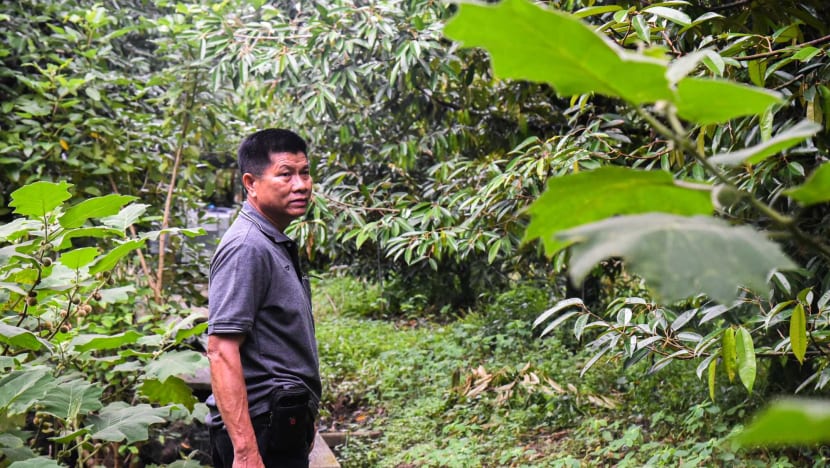
BAMBOO TO THE RESCUE
In the province of Samut Songkhram, an alien structure lies slightly offshore. A several kilometre-long bamboo wall made up of thousands of individual posts provides protection to the shoreline, home to a burgeoning mangrove forest.
Over the past decade, under the stewardship of 63-year-old retiree Witsoot Nuamsiri, this coastal fortress has been built and maintained. The bamboo is frail and usually can only withstand the waves for three to four years, before needing to be replaced. It is a painstaking process.
In the relative shelter behind the break, thousands of mangrove saplings are taking root. They form not only important ecosystems, but a more permanent coastal defence.
Volunteers from the local communities, universities and high schools are regular visitors to plant more mangroves, which will ideally stretch out further offshore towards the wall.

Erosion is rife along the Gulf of Thailand, the body of water whose coastline extends from the country’s deep south to the eastern border with Cambodia. Within Thailand itself, the coastline spans 1,660 kilometres, about a third of which is suffering from severe erosion of at least five metres a year.
READ: 'When is the next flood?' - Bangkok's canal communities fear they are living on borrowed time
Without urgent action, the future possible wave surge zone means far greater risks of inundation in Bangkok and other parts of central Thailand.
The stakes are high. Bangkok is watching nearby sea levels rise as it slowly sinks, a subsidence issue that will only magnify water problems in the coming years.
There are already strict laws in place to prevent groundwater extraction around the capital. “It works right now. But in order to prevent salt intrusion from other factors, for example high waves, we still have a problem,” said Somkiat of the Office of National Water Resources.
“The government sector cannot control all water. The water comes from the sky. We cannot turn off and turn on the rainfall but we just know when it comes and how much it comes. Sometimes we cannot avoid the problems from the flood and drought,” he added.
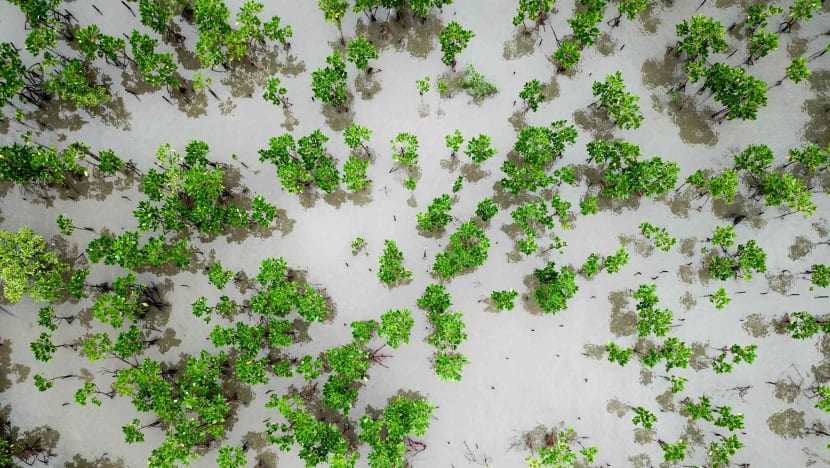
For generations, natural mangrove forests were cleared by local communities, who replaced them with shrimp farms or used the land for other purposes. It left coastal lands at the mercy of the waves and prone to flash flooding from storms, which are occurring more regularly, particularly in the southern provinces on the gulf.
“In the past, the water would just erode the coastline, but now, the water also reaches the villages. This is very scary,” said Payom of Prince of Songkla University.
The efforts to replenish mangrove stocks are part of the solution to keep the salt at bay and coastal erosion under control. So far in this part of Samut Songkhram, the project has been working.
Previously, nearby villagers were prone to flooding, which saw people forced to relocate. “It’s been 12 or 13 years now. The results show that in my village, people no longer have to move away,” Witsoot, the retiree, said.
“In the past, with the climate, the rains came seasonally and the storms came seasonally. But now they are getting stronger and stronger. All of this comes from the hands of humans.
“If we kept fleeing, where would life be in the future?”
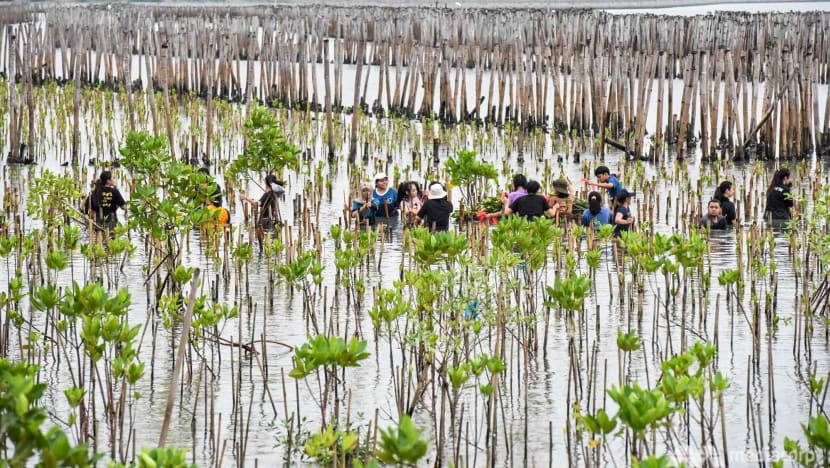
READ: The Thai government wanted to pave paradise, but this forest community said no
"YOU WILL HAVE NO TIME"
Authorities have announced recent success in extending the coverage of mangroves across the country by 32,000 hectares since 2014, according to Natural Resources and Environment Minister Varawut Silpa-archa.
Many of these projects use bamboo as a defence solution, which buys time for young mangroves to strengthen.
“If we replant mangroves now in front of the seas, they will not survive. We need to stop the wave environment and currents, and then we can replant,” Dr Seree Supratid, director of the Climate Change and Disaster Center at Rangsit University, explained.
But there is controversy about using bamboo, a resource heavy and short term solution. Along the gulf coastline, there are also different and inconsistent techniques being used. In some communities, concrete dykes of various designs and sizes are in place. Other parts of the coast are completely exposed, as their beaches file away.
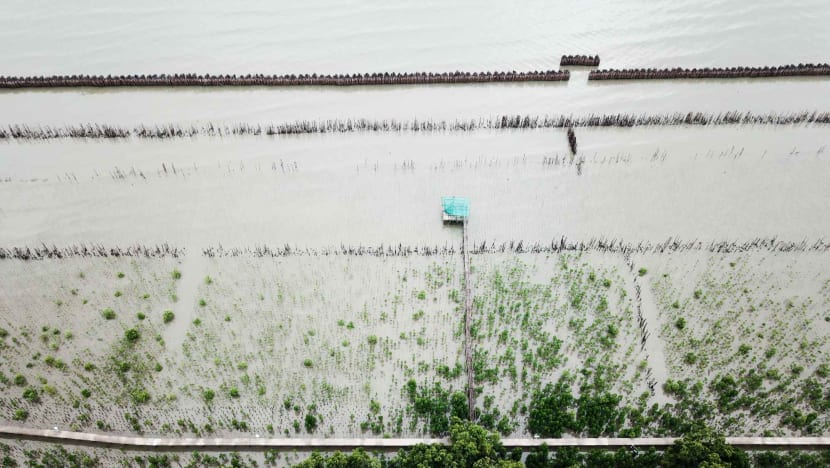
READ: IN FOCUS - Livelihoods, environment on the line as Thailand pushes for new industrial park
Asst Prof Payom believes the methods being used to replant mangroves are wasteful. He says the survival rate of young mangroves planted in the ground without protection is just 0.1 per cent - with some form of barrier it rises to about 33 per cent.
Just last year, a Thai study published in the Marine Pollution Bulletin labelled the coastal bamboo fences “well intentioned, but poorly implemented”, citing widespread debris damage to the very trees being planted.
“It’s the time we stop planting mangrove forest the old way because there’s so much failure,” Payom said.
“Bamboos are cheap and can be replaced but they aren’t sustainable. For the concrete barriers, during storm seasons, when waves hit the barriers, they will have reflective force.
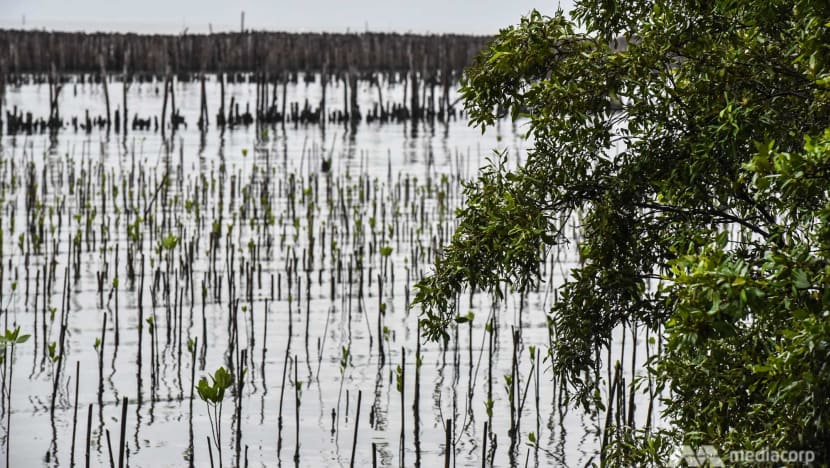
“The waves will be double in height with eight-fold power. It’s destruction. Instead of fixing and preventing the problem, it accelerates the erosion and makes everything worse.”
Seree of Rangsit University says the government needs to take more coordinated and pressing action. “The sea level rise is higher than first thought. If you don’t invest now, you cannot catch up with that kind of damage,” he said. “It will take 10 to 20 years to finish these projects."
He added: “I would like to say to the government, please don’t talk. Do it now. You will have no time.”
Additional reporting by Ryn Jirenuwat.














